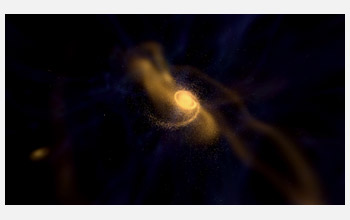Multimedia Gallery
Formation of the Milky Way
This image, taken from a visualization created by the Advanced Visualization Laboratory at the National Center for Supercomputing Applications (NCSA), shows the formation of the Milky Way galaxy at 16 million to 13.7 billion years old. Brian O'Shea of Michigan State University (formerly of Los Alamos National Laboratory) and Michael Norman of the University of California at San Diego collaborated on this research.
O'Shea was awarded a National Science Foundation Petascale Computing Resource Allocations award that will allow him to simulate hundreds of thousands of galaxies on Blue Waters, a sustained-petascale supercomputer at NCSA. These simulations will give a much better look at the first billion years after the big bang, a time in the development of the universe that is little understood. "A whole lot of stuff went on in that first billion years... a lot of galaxy formation took place. The universe was dense. Everything was close together. The rate at which things happened was really, really fast," he says.
To learn more about O'Shea's research with NCSA, see the article
"Leaving the Dark Days," in the Fall 2009 issue of NCSA Access magazine. Further information about the Blue Waters project is available Here. [Research supported by National Science Foundation grant OCI 08-32662.] (Date of Image: 2006)
Credit: National Center for Supercomputing Applications
Images and other media in the National Science Foundation Multimedia Gallery are available for use in print and electronic material by NSF employees, members of the media, university staff, teachers and the general public. All media in the gallery are intended for personal, educational and nonprofit/non-commercial use only.
Images credited to the National Science Foundation, a federal agency, are in the public domain. The images were created by employees of the United States Government as part of their official duties or prepared by contractors as "works for hire" for NSF. You may freely use NSF-credited images and, at your discretion, credit NSF with a "Courtesy: National Science Foundation" notation.
Additional information about general usage can be found in Conditions.
Also Available:
Download the high-resolution JPG version of the image. (1.4 MB)
Use your mouse to right-click (Mac users may need to Ctrl-click) the link above and choose the option that will save the file or target to your computer.

